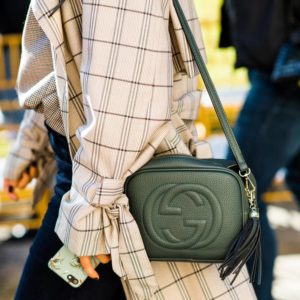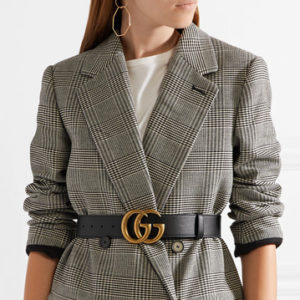Web 2.0: Influencers Influencing Fashion Marketing
Technology has grown exponentially over the past two decades, depicted in the chart on technology ownership trends by Pew Research below.  There is no doubt that our attachment to technology has a large influence on our day to day lives. Anytime there’s a slow moment, we reach for our phones to occupy the time – flipping through social media, liking a few posts, replying to others, and absorbing what the internet inexplicitly tells us to value.
There is no doubt that our attachment to technology has a large influence on our day to day lives. Anytime there’s a slow moment, we reach for our phones to occupy the time – flipping through social media, liking a few posts, replying to others, and absorbing what the internet inexplicitly tells us to value.
With the growth of social media, what it means to be an influencer has shifted. Before, influencers were limited to celebrities. Their artistic profession as musicians and actors requires a high level of public visibility, resulting in higher social status and influential power over their fan-base.
However today, the Internet allows anybody to achieve this high level of visibility to become an influencer. Fashion blogs develop a following of consumers who enjoy the particular brand a person created for themselves and which they use to share personal opinions and knowledge in fashion and beauty. Thus influencers convey to their audience what to value, what is important, and what is trending. By sharing one’s life, values, passions, and talents, anybody can use the Internet to build a community, a paying job, and increase their social status.
The number of influencers is growing, along with their influence on consumers’ activity. This is reshaping brands’ marketing techniques. Many companies believe that to effectively market to consumers, whose eyes are most often turned on social media, they must reach out to influencers to request that the influencer endorse their product. Thus brands reach that influencer’s unique set of consumers who are told that this product should be interesting to them based on the influencer’s support of it.
Gucci and Italian brands’ success
For instance, let’s consider Gucci. Gucci was founded in 1921 by Guccio Gucci in Florence, Tuscany. They view themselves as 21st Century innovators and take pride in their luxury status, quality product, and Italian brand. Continually, Gucci Equilibrium is where Gucci explicitly shares their goals – Culture of Purpose – and updates their consumers on what they are doing to not only provide high-quality products that appeal to their consumers, but also protect the environment, abide by strong ethics, and protect their integrity and consumers’ respect for their company.
Gucci is one of the most successful fashion brands on the market. According to The Lyst Index, a quarterly analysis of the “hottest brands” based on Internet searches, purchases, and engagement, Gucci was the number one hottest brand of 2017. In 2018, they were number one in the fourth and second quarters and number two in the third and first quarters.

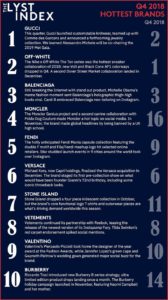
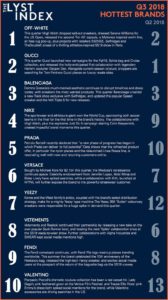
Across each of the four quarters in 2018 and the hottest brands of 2017 overall, all of the brands are high-end luxury brands and the large majority of them are Italian.

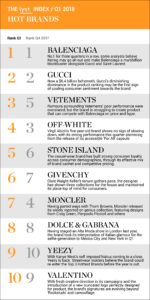
So, what makes Italian fashion so successful? Is it their association with Made-in-Italy, the high quality, well-made products?
Or is there something else, such as their marketing and social media techniques that are raising them up above luxury fashion labels in France, Britain, or the United States?
Gucci (and other Italian fashion labels) were reluctant to take part in the social media and influencer marketing strategy of today. They are older established brands who cater to an exclusive high-class customer. Therefore, they most likely viewed the publicity and mainstream nature of social media as beneath their brand. Yet, in early 2015, Gucci was struggling. They had poor sales because they were seen as outdated.
Since then, Gucci embraced social media and influencer marketing. As Gucci went about remarketing their brand and accepting social media as a necessity, it appears that they focused on being more deliberate when using influencer marketing, sticking only to working with a small number of influencers. This strategy allows them to maintain some more control over their image while taking advantage of the benefits of social media outreach, resulting in over 50% of their sales coming from millennials in 2017.
What about other non-Italian brands?
According to Gartner L2’s 2018 Digital IQ Index: Fashion Global, Gucci has the highest digital IQ of the global fashion industry; however, most of the following brands are not Italian.
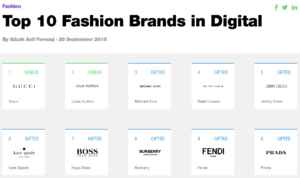
- Gucci
- Louis Vuitton
- Michael Kors
- Ralph Lauren
- Jimmy Choo
- Kate Spade
- Hugo Boss
- Burberry, Fendi, Prada
If these other, non-Italian brands have better digital marketing than Italian brands, then why are there so few that make it in the top 10 on The Lyst Index?
In November 2018, Michael Kors reported earnings that were less than expected for fiscal quarter two and saw their shares drop over 14%. They are struggling to maintain their brand prestige as their bags can be found at TJ Maxx and Marshalls at discount prices. Their high success in the digital sector could be an indicator of their effort to bounce back and make their products more desirable again, as opposed to an indication that their brand is particularly successful.
Made in Italy
Italian brands have something going for them that luxury fashion brands from other countries do not: Made in Italy. The Made in Italy brand, as described in Sonnet Stanfill’s Italian Style, means high quality, long lasting products that are hand-crafted by skilled and well-compensated laborers using the best materials possible. Consumers who purchase a Made in Italy product know that they are getting the best possible.
Luxury brands from America, France, or Britain do not have the benefit of being a part of an all-encompassing brand such as Made in Italy. Perhaps this is why they are higher on the list for digital IQ; they need to work harder than Italian brands to engage their consumers.
Additionally, as with Michael Kors, other labels may be struggling to maintain their image as a prestigious luxury brand. Italian brands, because they are Made in Italy, already have that status of prestige and know it. They keep a tight watch over their production and sales to prevent from losing their prestige because of overexposure or discounted prices.
While social media and influencer marketing is essential to maintain consumer engagement and sales, a brand cannot survive solely on a strong media presence. The Made in Italy brand brings pride to Italian fashion labels and helps them maintain their success in the fashion industry through their commitment to a great product, allowing them to rise above luxury fashion brands from other countries.
References
“About Gucci.” Gucci Official Site United States, Guccio Gucci S.p.A, www.gucci.com/us/en/st/about-gucci.
Farooqi, Alizah Asif. “Top 10 Fashion Brands in Digital.” Gartner L2: Benchmarking Digital Performance, Gartner, Inc, 28 Sept. 2018, www.l2inc.com/daily-insights/top-10-fashion-brands-in-digital-4.
“Gucci Belt Outfit.” Net-a-Porter, Net-a-Porter, www.net-a-porter.com/us/en/product/741153/gucci/leather-belt.
“Gucci Logo.” Wikipedia, Wikimedia Foundation, Inc., en.wikipedia.org/wiki/Gucci.
Hanbury, Mary. “Michael Kors Is in Danger of Getting ‘Lost in a Sea of ‘Stuff”.” Business Insider, Business Insider, 7 Nov. 2018, www.businessinsider.com/michael-kors-tj-maxx-image-problem-analyst-2018-11.
“Home.” Gucci Equilibrium, Guccio Gucci S.p.A, equilibrium.gucci.com/?utm_medium=gucci.com&utm_source=gucci.com_us&utm_campaign=equilibrium_launch_june18&utm_content=footer.
Luna, Becca Risa. “Gucci Bans Influencer Gifting, Here’s What They’re Doing Instead.” Coffee and Handbags, WordPress, 23 Sept. 2018, coffeeandhandbags.com/2018/09/13/gucci-bans-influencer-gifting-heres-what-theyre-doing-instead/.
Pew Research Center. “The Share of Americans Using Various Technologies Has Stayed Relatively Flat since 2016.” Pew Research Center, Http://Www.pewresearch.org/Fact-Tank/2018/09/28/Internet-Social-Media-Use-and-Device-Ownership-in-u-s-Have-Plateaued-after-Years-of-Growth/, 28 Sept. 2018. Survey conducted January 3-10, 2018 and trend data are from previous Pew Research Center studies
“The Lyst Index 2017 / Hottest Brands of the Year: 2017.” Business of Fashion, Lyst, www.businessoffashion.com/articles/sponsored-feature/the-hottest-brands-in-2017-gucci-vs-balenciaga.
“The Lyst Index / Q1 2018.” Business of Fashion, 24 Apr. 2018, www.businessoffashion.com/articles/sponsored-feature/the-truth-about-vetements-and-fashions-hottest-brands-and-top-selling-products-in-q1.
“The Lyst Index / Q2 2018.” Lyst, 2018, www.lyst.com/news/lyst-index-q2-2018/.
“The Lyst Index / Q3 2018.” Snobette, 24 Oct. 2018, snobette.com/2018/10/hottest-brand-off-white-gucci-balenciaga/.
“The Lyst Index / Q4 2018.” The Moodie Davitt Report, 7 Feb. 2019, www.moodiedavittreport.com/gucci-named-worlds-hottest-brand-in-lysts-quarterly-fashion-rankings/.
“Made in Italy Logo/Image.” Business e via Italy, Business e via Italy, www.businesseviaitaly.com/single-post/2017/06/21/%E2%80%9CMade-in-Italy%E2%80%9D-export-keeps-accelerating-4-growth-in-the-next-four-years-up-to-%E2%82%AC490-billion.
Semburg, Sandra. “Street Style with Gucci Bag.” Vogue, Condé Nast Britain, 3 Jan. 2019, www.vogue.co.uk/article/the-most-iconic-gucci-bags-of-all-time.
WWC Staff. “Gucci: A History Lesson.” WWD, Penske Media Corporation, 23 Feb. 2011, wwd.com/fashion-news/designer-luxury/history-lesson-3512770/.

